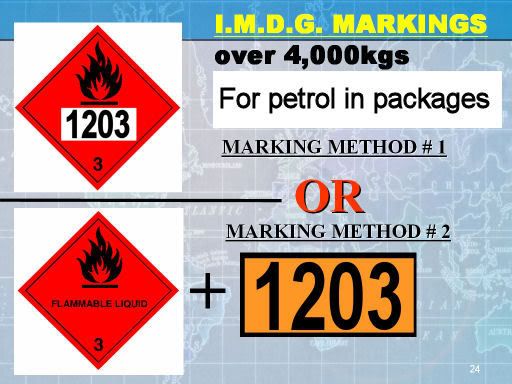The topic below is copied in from ![]() HERE
HERE
(ISO container markings for the carriage of dangerous goods.)
dambuster:
Are there any legalities involved if a non ADR trained/qualified driver pulls a box/trailer/truck marked up with the 4 stickers and UN codes after it’s been tipped/running empty ?
Hi dambuster, yes mate, there are some legalities involved…
If a vehicle or ISO container isn’t carrying dangerous goods, then all of the dangerous goods markings must be removed or effectively covered.
Given that you’ve mentioned “a non ADR trained/qualified driver” was driving it, he/she probably wouldn’t know the importance of removing/covering the four placards. The fact that no dangerous goods were being carried means that it is completely irrelevant whether the driver has an ADR licence or not. It doesn’t necessarily follow that just because an ISO container needs placards, an ADR licence is also required.
Just for now, it’s best to think of the ISO container and the carrying vehicle as two separate items…
ISO Container
If any amount of any kind of dangerous goods are in an ISO container, then under ADR the ISO container requires to have the relevant placards on all four sides.
Now let’s put the ISO container on a road vehicle… (The ISO container is already correctly marked now. ![]() )
)
ISO Container carrying vehicle
Normal ADR rules apply.
The ADR vehicle markings (simply an orange plate at the front and another at the rear) might be required, depending on the ADR Transport Category of the dangerous goods AND the total amount loaded on the vehicle (in the ISO container.) If the orange plate requirement is triggered, then the vehicle driver also needs an ADR licence, correct paperwork, 2X fire-extinguishers and all other relevant PPE and equipment.
![]() Now for a surprise…
Now for a surprise… ![]()
The UN number of the dangerous goods being carried is only required by IMDG (the Regs for carrying dangerous goods BY SEA) and isn’t required by ADR. Under IMDG, (the Regs for carrying dangerous goods BY SEA) the requirement to display UN numbers is (normally) triggered when the amount of dangerous goods (in an ISO container OR on a road vehicle being carried on a ferry) exceeds 4,000 Kgs. At this point, the load may still not be subject to ADR if the goods aren’t regarded as dangerous BY ROAD.
Case study
Let’s imagine that petrol (in drums) is to be carried in an ISO container on a road vehicle.
Petrol is in ADR Transport Category 2, so the ADR ‘trigger’ limit is 333 ltrs.
(More than 333 ltrs means orange plates, ADR licence etc etc)
Due to the fact that there’s an ISO container on the carrying vehicle, there is an additional requirement for only standard UN Class 3 placards on all four sides of the ISO container. (Just four of the placard at the bottom left in the picture below.)
If the road vehicle carrying the ISO container (or just the ISO container) goes on a ferry or boat, then it’s already correctly marked for the sea journey (under IMDG.) IMDG does not recognise ADR’s orange plates, so theoretically, the orange plates could be removed for the sea journey, but nobody bothers about doing so.
If there’s more than 4,000Kgs of petrol going in an ISO container (whether on a road vehicle or not) then the following marking rules apply BY SEA: (There’s no preference, BOTH methods are acceptable under IMDG.)

Just because the UN number on an ISO container isn’t required by ADR on the road, it doesn’t mean that it’s illegal to have them on display for the purpose of obeying IMDG. By road, displaying a UN number simply means that you’d be ‘overmarked’ ie. above minimum spec.